DERIENet: A Deep Ensemble Learning Approach for High-Performance Detection of Jute Leaf Diseases
Abstract
1. Introduction
- We introduced DERIENet, a collaborative ensemble deep-learning architecture designed to accurately classify jute leaf diseases. DERIENet achieves a classification accuracy of 99.89% by integrating the predictive capabilities of several refined deep-learning models—EfficientNetB0, ResNet50, and InceptionV3—into a unified framework enhanced with regularization and dropout layers, significantly improving resilience and robustness against noise and variability in agricultural images.
- We proposed a novel data-augmentation pipeline, Geometric Localized Occlusion and Adaptive Rescaling (GLOAR), which dynamically perturbs image geometry and photometry based on entropy-aware heuristics. This critical innovation enabled the synthetic expansion of a limited dataset from 920 to 7800 images, dramatically enhancing generalization capability and mitigating overfitting in data-constrained scenarios.
- We designed a custom ensemble feature fusion strategy using global average pooling and dense layers with L2 regularization and batch normalization, which not only preserved discriminative features from individual CNN backbones but also facilitated a compact, low-variance representation, enabling higher classification fidelity with minimal computational overhead.
- We conducted a comprehensive comparative evaluation against multiple state-of-the-art baseline models, including MobileNetV2, DenseNet201, InceptionV3, VGG16, ResNet50, and EfficientNetB0, conclusively demonstrating DERIENet’s superior performance across all standard classification metrics and its statistical significance through ablation and ensemble analysis. Moreover, we demonstrated the model’s practical feasibility for real-time deployment in precision agriculture, validating its efficacy through precision, recall, and F1-score metrics, supported by interpretability tools such as ROC curves and confusion matrices, underscoring its potential for deployment on mobile or edge computing devices for in-field jute disease detection.
2. Literature Review
3. Methodology
3.1. Data Description
3.2. Data Preprocessing
3.2.1. Data Resizing
| Algorithm 1 Image resizing algorithm |
| Require: List of image files I, target dimensions (e.g., 224 × 224 pixels) |
| Ensure: Resized images saved in appropriate directories |
| 1: for each image do |
| 2: Open the image file |
| 3: if image is not in RGB format then |
| 4: Convert the image to RGB |
| 5: end if |
| 6: Resize the image to |
| 7: Save the resized image to the output directory |
| 8:end for |
3.2.2. Data Augmentation
| Algorithm 2 Geometric Localized Occlusion and Adaptive Rescaling (GLOAR) |
| Require: Raw input image I |
| Ensure: Augmented image |
| 1: Compute global brightness B and entropy H of I |
| 2: Set augmentation intensity parameter , where f is a learnt or heuristic function |
| 3: Step 1: Geometric Transformations (weighted by ) |
| 4: Apply random affine transformation: rotation (), scaling (–), shear () |
| 5: Apply random translation ( of image height/width) |
| 6: Apply perspective warping with probability |
| 7: Step 2: Localized Micro-Patch Jittering |
| 8: for to n random patches do |
| 9: Crop a patch of size – at a random location |
| 10: Apply perturbation: small rotation, pixel shuffle, or blur on |
| 11: Reinsert into its original location in I |
| 12: end for |
| 13: Step 3: Photometric Transformations (entropy-aware) |
| 14: Adjust brightness in range |
| 15: Adjust contrast in range |
| 16: Convert to HSV color space |
| 17: Perturb hue by |
| 18: Scale saturation in range |
| 19: return Augmented image |
3.3. Train, Validation and Test Split
3.4. Proposed DERIENet Model
DERIENet Architecture
3.5. Baseline Models
3.5.1. EfficientNetB0
3.5.2. ResNet50
3.5.3. InceptionV3
3.5.4. MobileNetV2
3.5.5. DenseNet201
3.5.6. VGG16
3.6. Model Performance Metrics
3.6.1. Accuracy
3.6.2. Precision
3.6.3. Recall
3.6.4. F1-Score
4. Results and Discussion
4.1. Results of Baseline Models
4.1.1. Confusion Matrix Analysis
4.1.2. ROC Curve Analysis
4.2. Results of Proposed DERIENet Model
4.3. Model Performance Comparison
4.4. Ablation Study
5. Discussion
6. Conclusions
Author Contributions
Funding
Institutional Review Board Statement
Informed Consent Statement
Data Availability Statement
Conflicts of Interest
References
- Ahmed, Z.; Sarkar, S. Review on jute leaf: A powerful biological tool. Int. J. Sci. Res. Updat. 2022, 4, 64–85. [Google Scholar] [CrossRef]
- Islam, M.M. Advanced Production Technology and Processing of Jute. In Agronomic Crops: Volume 1: Production Technologies; Springer: Singapore, 2019; pp. 387–440. [Google Scholar] [CrossRef]
- Sharna, S.C.; Kamruzzaman, M. Comparative advantages of jute export in Bangladesh, China and India. Res. Agric. Livest. Fish. 2020, 7, 183–190. [Google Scholar] [CrossRef]
- Miah, M.J.; Khan, M.A.; Khan, R.A. Fabrication and characterization of jute fiber reinforced low density polyethylene based composites: Effects of chemical treatment. J. Sci. Res. 2011, 3, 249–259. [Google Scholar] [CrossRef]
- Akter, S.; Sadekin, M.N.; Islam, N. Jute and jute products of Bangladesh: Contributions and challenges. Asian Bus. Rev. 2020, 10, 143–152. [Google Scholar] [CrossRef]
- Islam, M.M. Biochemistry, Medicinal and Food values of Jute (Corchorus capsularis L. and C. olitorius L.) leaf: A Review. Int. J. Enhanc. Res. Sci. Technol. Eng. 2013, 2, 35–44. [Google Scholar]
- Uddin, M.S.; Munsi, M.Y. Juledi: Jute leaf disease identification using convolutional neural network. In Proceedings of the International Conference on Information, Communication and Computing Technology, New Delhi, India, 27 May 2023; Springer: Berlin/Heidelberg, Germany, 2023; pp. 661–677. [Google Scholar]
- Li, L.; Zhang, S.; Wang, B. Plant Disease Detection and Classification by Deep Learning—A Review. IEEE Access 2021, 9, 56683–56698. [Google Scholar] [CrossRef]
- Biswas, M.E.; Sultana, T.; Mandal, A.K.; Morshed, M.G.; Hossain, M.D. Spatio-temporal feature engineering and selection-based flight arrival delay prediction using deep feedforward regression network. Electronics 2024, 13, 4910. [Google Scholar] [CrossRef]
- Biswas, M.E.; Hossain, M.D.; Huh, E.-N.; Sultana, T. Spatiotemporal Data-Driven Hourly Bike-Sharing Demand Prediction Using ApexBoost Regression. Int. J. Data Sci. Anal. 2025, 1–24. [Google Scholar] [CrossRef]
- Lu, J.; Tan, L.; Jiang, H. Review on convolutional neural network (CNN) applied to plant leaf disease classification. Agriculture 2021, 11, 707. [Google Scholar] [CrossRef]
- Albahli, S.; Nawaz, M. DCNet: DenseNet-77-based CornerNet model for the tomato plant leaf disease detection and classification. Front. Plant Sci. 2022, 13, 957961. [Google Scholar] [CrossRef]
- Matin, M.M.H.; Khatun, A.; Moazzam, M.G.; Uddin, M.S. An efficient disease detection technique of rice leaf using AlexNet. J. Comput. Commun. 2020, 8, 49–57. [Google Scholar] [CrossRef]
- Arya, S.; Singh, R. A Comparative Study of CNN and AlexNet for Detection of Disease in Potato and Mango leaf. In Proceedings of the 2019 International Conference on Issues and Challenges in Intelligent Computing Techniques (ICICT), Ghaziabad, India, 27–28 September 2019; IEEE: Piscataway, NJ, USA, 2019; Volume 1, pp. 1–6. [Google Scholar]
- Tanny, M.T.Y.; Biswas, M.E.; Akter, A.; Modok, C.K.; Nipu, M.H.N.; Hasan, M.; Hossain, M.D.; Mandal, A.K.; Hossain, M.S.; Sultana, T. Customized EfficientNet: A Transfer Learning Approach for Rice Leaf Disease Classification with Advanced Resizing and Augmentation. In Proceedings of the 2025 International Conference on Electrical, Computer and Communication Engineering (ECCE), Chittagong, Bangladesh, 13–15 February 2025; IEEE: Piscataway, NJ, USA, 2025; pp. 1–6. [Google Scholar]
- Kunduracıoğlu, İ.; Paçal, İ. Deep Learning-Based Disease Detection in Sugarcane Leaves: Evaluating EfficientNet Models. J. Oper. Intell. 2024, 2, 321-235. [Google Scholar] [CrossRef]
- Yang, L.; Yu, X.; Zhang, S.; Long, H.; Zhang, H.; Xu, S.; Liao, Y. GoogLeNet based on residual network and attention mechanism identification of rice leaf diseases. Comput. Electron. Agric. 2023, 204, 107543. [Google Scholar] [CrossRef]
- Adedoja, A.; Owolawi, P.A.; Mapayi, T. Deep learning based on nasnet for plant disease recognition using leave images. In Proceedings of the 2019 International Conference on Advances in Big Data, Computing and Data Communication Systems (icABCD), Winterton, South Africa, 5–6 August 2019; IEEE: Piscataway, NJ, USA, 2019; pp. 1–5. [Google Scholar]
- Li, X.; Rai, L. Apple leaf disease identification and classification using resnet models. In Proceedings of the 2020 IEEE 3rd International Conference on Electronic Information and Communication Technology (ICEICT), Shenzhen, China, 13–15 November 2020; IEEE: Piscataway, NJ, USA, 2020; pp. 738–742. [Google Scholar]
- Bi, C.; Wang, J.; Duan, Y.; Fu, B.; Kang, J.R.; Shi, Y. MobileNet based apple leaf diseases identification. Mob. Netw. Appl. 2022, 27, 172–180. [Google Scholar] [CrossRef]
- Elfatimi, E.; Eryigit, R.; Elfatimi, L. Beans leaf diseases classification using mobilenet models. IEEE Access 2022, 10, 9471–9482. [Google Scholar] [CrossRef]
- Theerthagiri, P.; Ruby, A.U.; Chandran, J.G.C.; Sardar, T.H.; Shafeeq BM, A. Deep SqueezeNet learning model for diagnosis and prediction of maize leaf diseases. J. Big Data 2024, 11, 112. [Google Scholar] [CrossRef]
- Haque, R.; Miah, M.M.; Sultana, S.; Fardin, H.; Noman, A.A.; Al-Sakib, A.; Hasan, M.K.; Rafy, A.; Shihabur, R.M.; Rahman, S. Advancements in Jute Leaf Disease Detection: A Comprehensive Study Utilizing Machine Learning and Deep Learning Techniques. In Proceedings of the 2024 IEEE International Conference on Power, Electrical, Electronics and Industrial Applications (PEEIACON), Rajshahi, Bangladesh, 12–13 September 2024; pp. 248–253. [Google Scholar] [CrossRef]
- Paymode, A.S.; Malode, V.B. Transfer learning for multi-crop leaf disease image classification using convolutional neural network VGG. Artif. Intell. Agric. 2022, 6, 23–33. [Google Scholar] [CrossRef]
- Sreedevi, A.; Srinivas, K. Deep learning methodologies towards leaf disease detection: A review. In Impending Inquisitions in Humanities and Sciences; CRC Press: Boca Raton, FL, USA, 2024; pp. 270–280. [Google Scholar]
- Vats, S.; Kukreja, V.; Mehta, S. A New Era in AgriTech: Federated Learning CNN for Jute Leaf Disease Identification. In Proceedings of the 2024 IEEE International Conference on Interdisciplinary Approaches in Technology and Management for Social Innovation (IATMSI), Gwalior, India, 14–16 March 2024; Volume 2, pp. 1–6. [Google Scholar] [CrossRef]
- Rahman, M.I.; Nazim Uddin, M. Jute Plant Disease Detection by obtaining RoI with SGM using Image Processing Technique and CNN. In Proceedings of the 2023 26th International Conference on Computer and Information Technology (ICCIT), Cox’s Bazar, Bangladesh, 13–15 December 2023; pp. 1–6. [Google Scholar] [CrossRef]
- Daphal, S.D.; Koli, S.M. Enhancing sugarcane disease classification with ensemble deep learning: A comparative study with transfer learning techniques. Heliyon 2023, 9, e18261. [Google Scholar] [CrossRef] [PubMed]
- Patil, R.R.; Kumar, S. Rice-fusion: A multimodality data fusion framework for rice disease diagnosis. IEEE Access 2022, 10, 5207–5222. [Google Scholar] [CrossRef]
- Yigit, E.; Sabanci, K.; Toktas, A.; Kayabasi, A. A study on visual features of leaves in plant identification using artificial intelligence techniques. Comput. Electron. Agric. 2019, 156, 369–377. [Google Scholar] [CrossRef]
- Hasan, M.Z.; Ahamed, M.S.; Rakshit, A.; Hasan, K.M.Z. Recognition of Jute Diseases by Leaf Image Classification using Convolutional Neural Network. In Proceedings of the 2019 10th International Conference on Computing, Communication and Networking Technologies (ICCCNT), Kanpur, India, 6–8 July 2019; pp. 1–5. [Google Scholar] [CrossRef]
- Li, D.; Ahmed, F.; Wu, N.; Sethi, A.I. Yolo-JD: A Deep Learning Network for jute diseases and pests detection from images. Plants 2022, 11, 937. [Google Scholar] [CrossRef]
- Akhand, M.N. Deep Learning-Based Jute Leaf Disease Identification. In Proceedings of the Undergraduate Conference on Intelligent Computing and Systems (UCICS 2025), Varendra University, Rajshahi, Bangladesh, 26–27 February 2025. [Google Scholar]
- Hridoy, R.H.; Yeasmin, T.; Mahfuzullah, M. A deep multi-scale feature fusion approach for early recognition of jute diseases and pests. In Inventive Systems and Control: Proceedings of ICISC 2022; Springer: Berlin/Heidelberg, Germany, 2022; pp. 553–567. [Google Scholar]
- Kaushik, P.; Khurana, S. Jute Leaf Disease Detection using ResNet50: A Deep Learning Approach for Precision Agriculture. In Proceedings of the 2025 International Conference on Electronics and Renewable Systems (ICEARS), Tuticorin, India, 11–13 February 2025; pp. 1901–1906. [Google Scholar] [CrossRef]
- Sourav, M.S.U.; Wang, H. Intelligent identification of jute pests based on transfer learning and deep convolutional neural networks. Neural Process. Lett. 2023, 55, 2193–2210. [Google Scholar] [CrossRef]
- Karim, D.Z.; Bushra, T.A.; Saif, M.M. PestDetector: A Deep Convolutional Neural Network to Detect Jute Pests. In Proceedings of the 2022 4th International Conference on Sustainable Technologies for Industry 4.0 (STI), Los Alamitos, CA, USA, 17–18 December 2022; pp. 1–6. [Google Scholar] [CrossRef]
- Talukder, M.S.H.; Chowdhury, M.R.; Sourav, M.S.U.; Rakin, A.A.; Shuvo, S.A.; Sulaiman, R.B.; Nipun, M.S.; Islam, M.; Islam, M.R.; Islam, M.A.; et al. JutePestDetect: An intelligent approach for jute pest identification using fine-tuned transfer learning. Smart Agric. Technol. 2023, 5, 100279. [Google Scholar] [CrossRef]
- Rana, S.; Samad, M.F. End-to-end jute-pest detection by explainable lightweight cnn. In Proceedings of the 2024 6th International Conference on Electrical Engineering and Information & Communication Technology (ICEEICT), Dhaka, Bangladesh, 2–4 May 2024; IEEE: Piscataway, NJ, USA, 2024; pp. 230–235. [Google Scholar]
- Islam, M.T.; Rahman, M.S. An Efficient Deep Learning Approach for Jute Pest Classification Using Transfer Learning. In Proceedings of the 2024 6th International Conference on Electrical Engineering and Information & Communication Technology (ICEEICT), Dhaka, Bangladesh, 2–4 May 2024; pp. 1473–1478. [Google Scholar] [CrossRef]
- Bansal, A.; Vats, S.; Prasad, C.; Kukreja, V.; Mehta, S. Collaborative Computing: Federated Learning CNNs for Jute Leaf Disease Analysis. In Proceedings of the 2024 3rd International Conference for Innovation in Technology (INOCON), Bangalore, India, 1–3 March 2024; pp. 1–6. [Google Scholar] [CrossRef]
- Rajput, K.; Garg, A.; Bhati, J.P.; Kukreja, V.; Mehta, S. Agricultural AI Insights: Deciphering Jute Leaf Diseases Through Federated Learning CNNs. In Proceedings of the 2024 10th International Conference on Advanced Computing and Communication Systems (ICACCS), Coimbatore, India, 14–15 March 2024; Volume 1, pp. 1589–1595. [Google Scholar] [CrossRef]
- Rajput, K.; Garg, A.; Kukreja, V.; Mehta, S. Agricultural Intelligence: Federated Learning CNN’s Models for Jute Leaf Disease Analysis. In Proceedings of the 2024 11th International Conference on Reliability, Infocom Technologies and Optimization (Trends and Future Directions) (ICRITO), Noida, India, 14–15 March 2024; pp. 1–6. [Google Scholar] [CrossRef]
- Rijal, T.R.; Karki, S. Evaluation of promising jute (Corchorus olitorius) germplasm against stem rot caused by (Macrophomina phaseolina)(Tassi) Goid. Int. J. Appl. Agric. Sci. 2022, 8, 192–195. [Google Scholar]
- Reza, Z.N.; Nuzhat, F.; Mahsa, N.A.; Ali, M.H. Detecting jute plant disease using image processing and machine learning. In Proceedings of the 2016 3rd International Conference on Electrical Engineering and Information Communication Technology (ICEEICT), Dhaka, Bangladesh, 22–24 September 2016; pp. 1–6. [Google Scholar] [CrossRef]
- Biswas, M.E.; Shahzamal, M.; Haque, M.D. Machine Learning Approach to Estimate Requirements for Target Productivity of Garments Employees. In Proceedings of the 2024 6th International Conference on Electrical Engineering and Information & Communication Technology (ICEEICT), Dhaka, Bangladesh, 2–4 May 2024; IEEE: New York, NY, USA, 2024; pp. 921–926. [Google Scholar]
- Biswas, M.E.; Ahamed, M.S.; Rafi, M.A.H.; Haque, M.D. An Adaptive Machine Learning Approach for Electrical Fault Detection and Minimization. In Proceedings of the 2024 2nd International Conference on Information and Communication Technology (ICICT), Dhaka, Bangladesh, 21–22 October 2024; IEEE: New York, NY, USA, 2024; pp. 274–278. [Google Scholar]
- Tan, M.; Le, Q. Efficientnet: Rethinking model scaling for convolutional neural networks. In Proceedings of the International Conference on Machine Learning, Long Beach, CA, USA, 9–15 June 2019; PMLR: Breckenridge, CO, USA, 2019; pp. 6105–6114. [Google Scholar]
- He, K.; Zhang, X.; Ren, S.; Sun, J. Deep residual learning for image recognition. In Proceedings of the IEEE Conference on Computer Vision and Pattern Recognition, Las Vegas, NV, USA, 27–30 June 2016; pp. 770–778. [Google Scholar]
- Szegedy, C.; Vanhoucke, V.; Ioffe, S.; Shlens, J.; Wojna, Z. Rethinking the Inception Architecture for Computer Vision. In Proceedings of the IEEE Conference on Computer Vision and Pattern Recognition (CVPR), Las Vegas, NV, USA, 27–30 June 2016. [Google Scholar]
- Sandler, M.; Howard, A.; Zhu, M.; Zhmoginov, A.; Chen, L.C. Mobilenetv2: Inverted residuals and linear bottlenecks. In Proceedings of the IEEE Conference on Computer Vision and Pattern Recognition, Salt Lake City, UT, USA, 18–22 June 2018; pp. 4510–4520. [Google Scholar]
- Huang, G.; Liu, Z.; Van Der Maaten, L.; Weinberger, K.Q. Densely connected convolutional networks. In Proceedings of the IEEE Conference on Computer Vision and Pattern Recognition, Honolulu, HI, USA, 21–26 July 2017; pp. 4700–4708. [Google Scholar]
- Simonyan, K.; Zisserman, A. Very deep convolutional networks for large-scale image recognition. arXiv 2014, arXiv:1409.1556. [Google Scholar]
- Grandini, M.; Bagli, E.; Visani, G. Metrics for multi-class classification: An overview. arXiv 2020, arXiv:2008.05756. [Google Scholar] [CrossRef]
- Ahmed, S.; Hasan, M.B.; Ahmed, T.; Sony, M.R.K.; Kabir, M.H. Less is more: Lighter and faster deep neural architecture for tomato leaf disease classification. IEEE Access 2022, 10, 68868–68884. [Google Scholar] [CrossRef]
- Barud Demilie, W. Plant disease detection and classification techniques: A comparative study of the performances. J. Big Data 2024, 11, 5. [Google Scholar] [CrossRef]
- Joseph, D.S.; Pawar, P.M.; Chakradeo, K. Real-Time Plant Disease Dataset Development and Detection of Plant Disease Using Deep Learning. IEEE Access 2024, 12, 16310–16333. [Google Scholar] [CrossRef]
- Pandian, J.A.; Kumar, V.D.; Geman, O.; Hnatiuc, M.; Arif, M.; Kanchanadevi, K. Plant disease detection using deep convolutional neural network. Appl. Sci. 2022, 12, 6982. [Google Scholar] [CrossRef]
- Bansal, P.; Kumar, R.; Kumar, S. Disease detection in apple leaves using deep convolutional neural network. Agriculture 2021, 11, 617. [Google Scholar] [CrossRef]
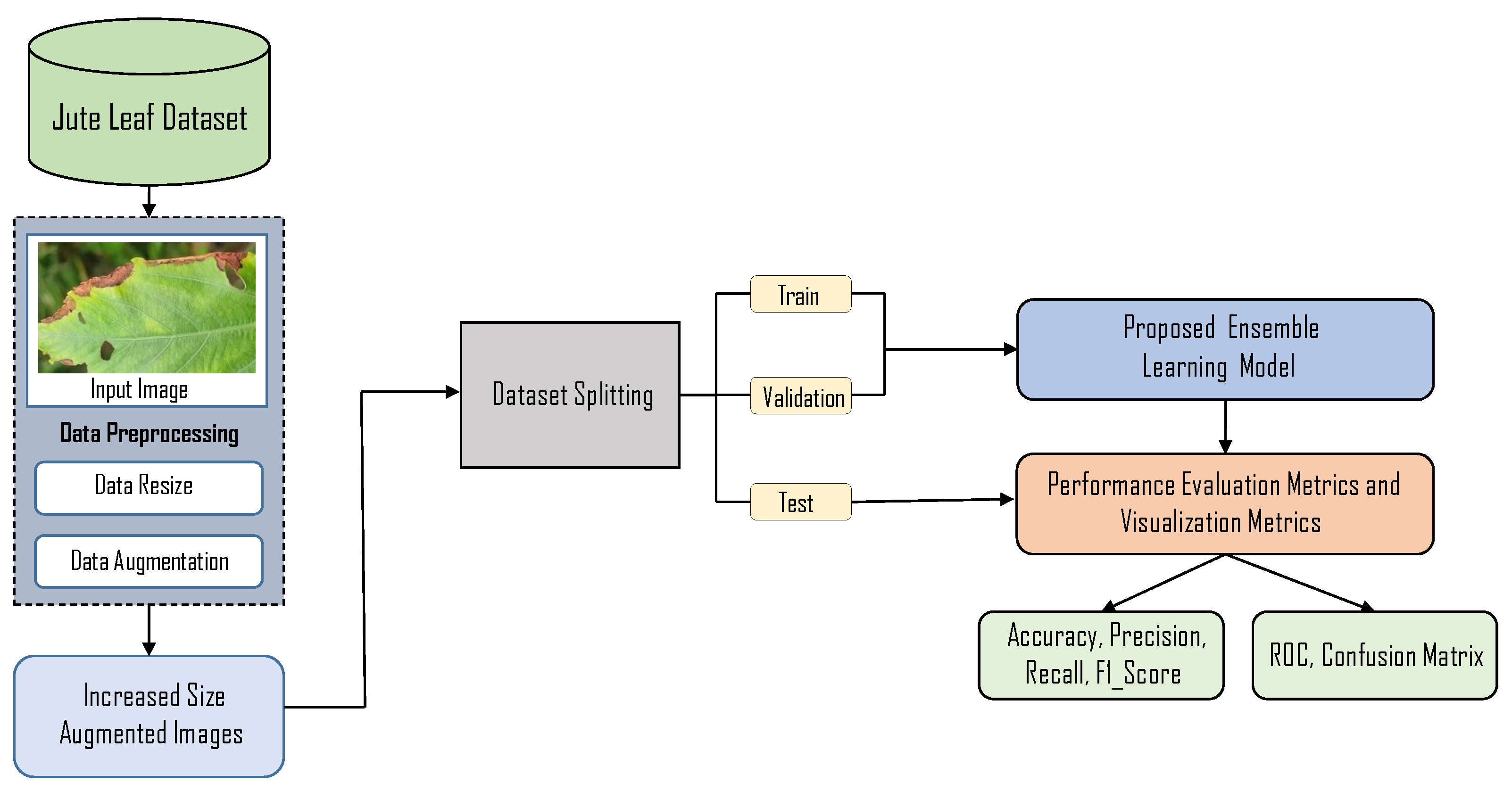
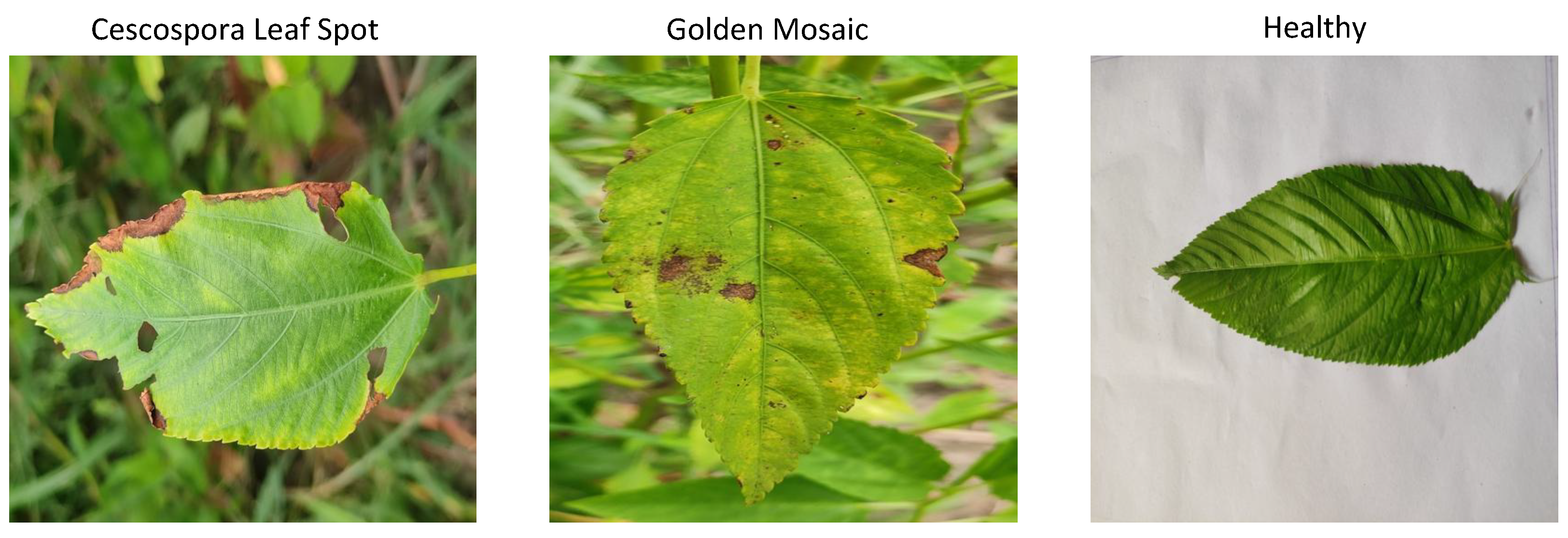
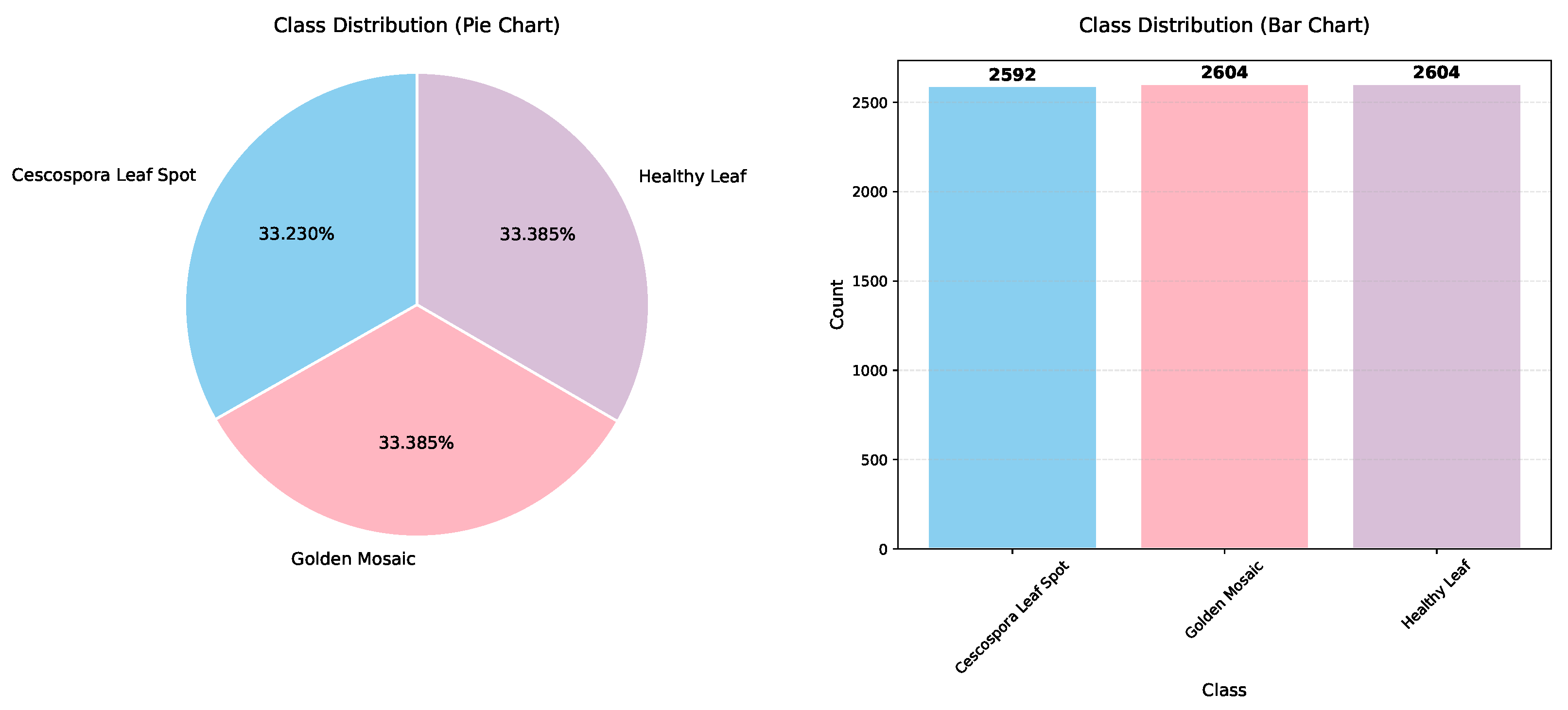

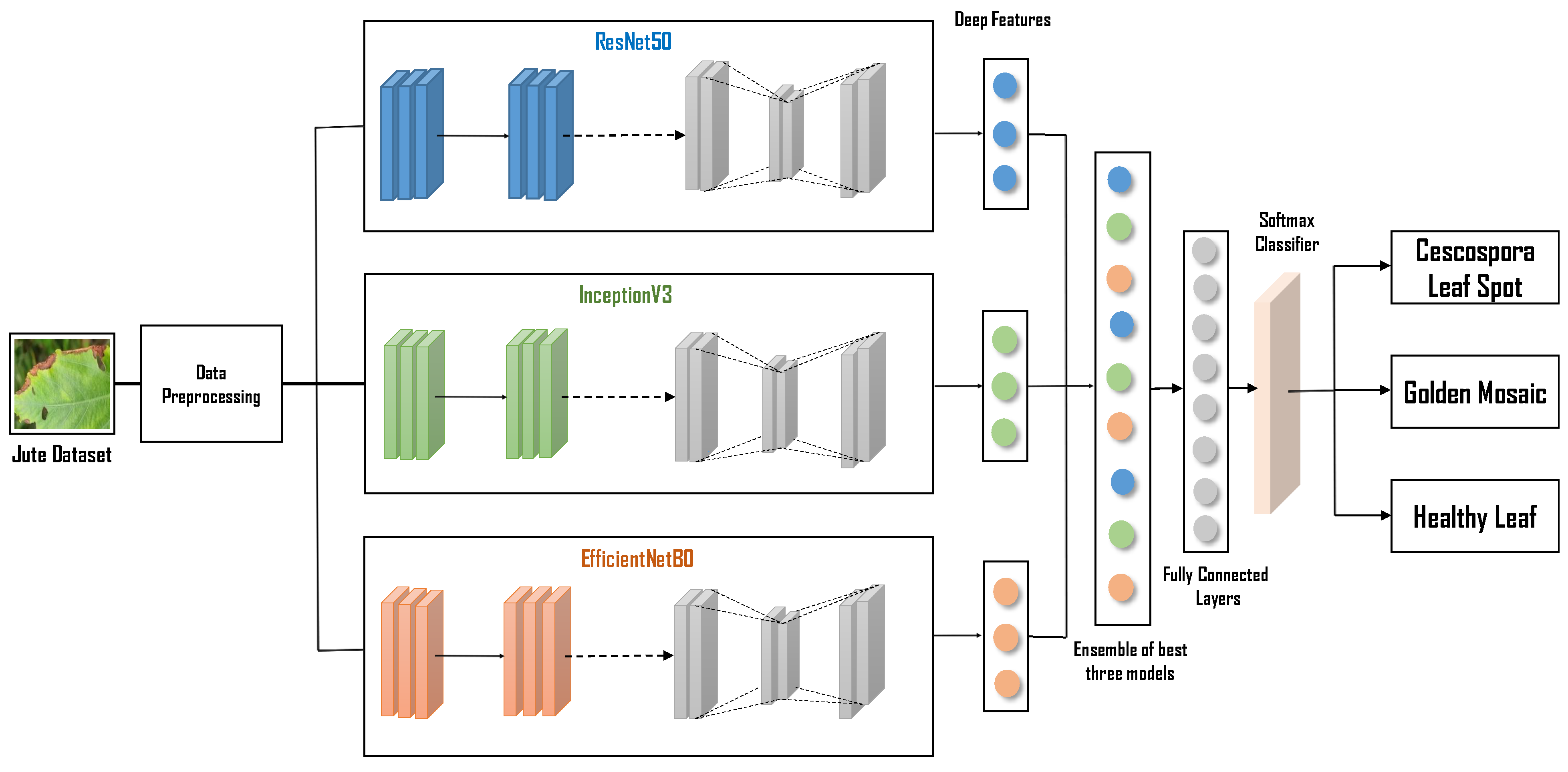
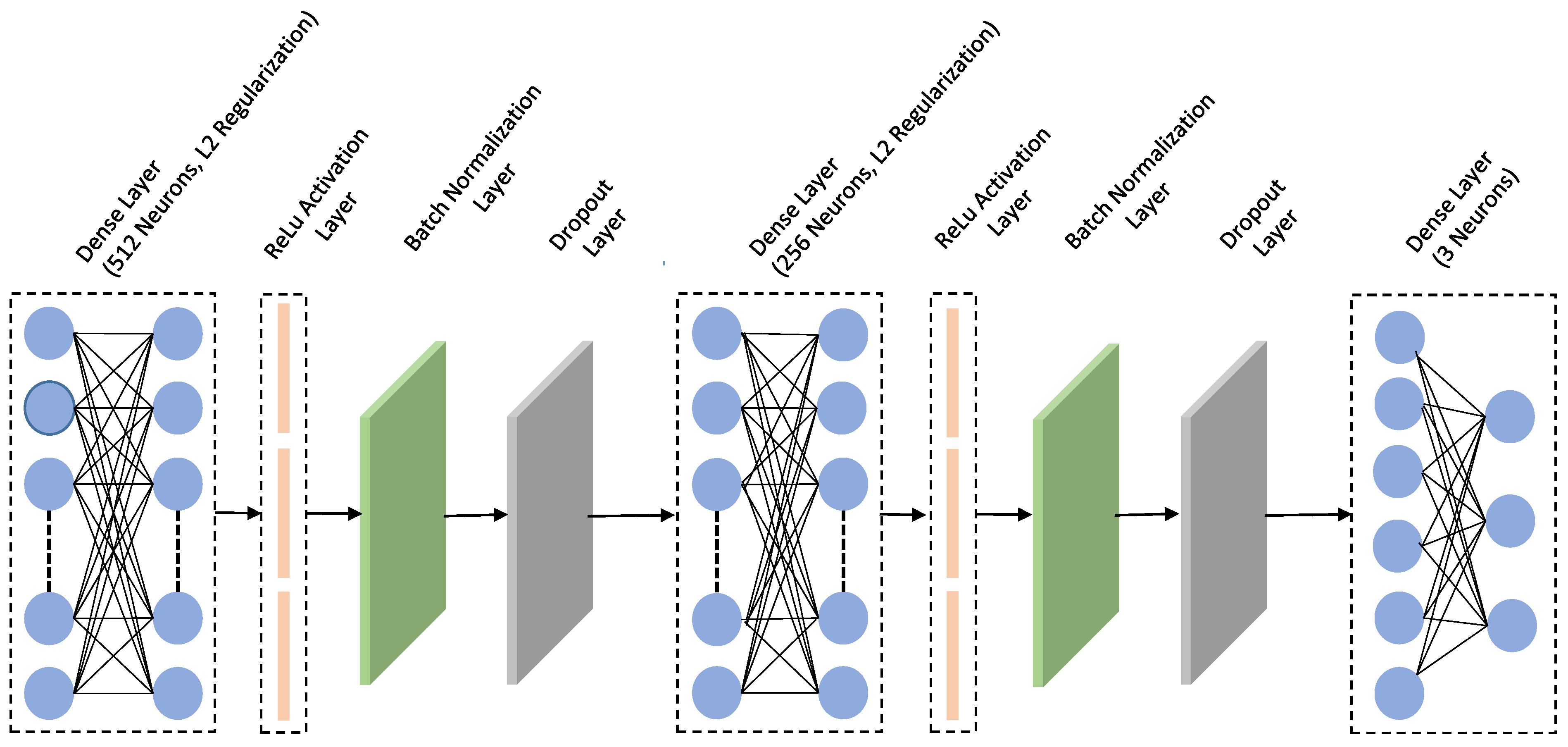
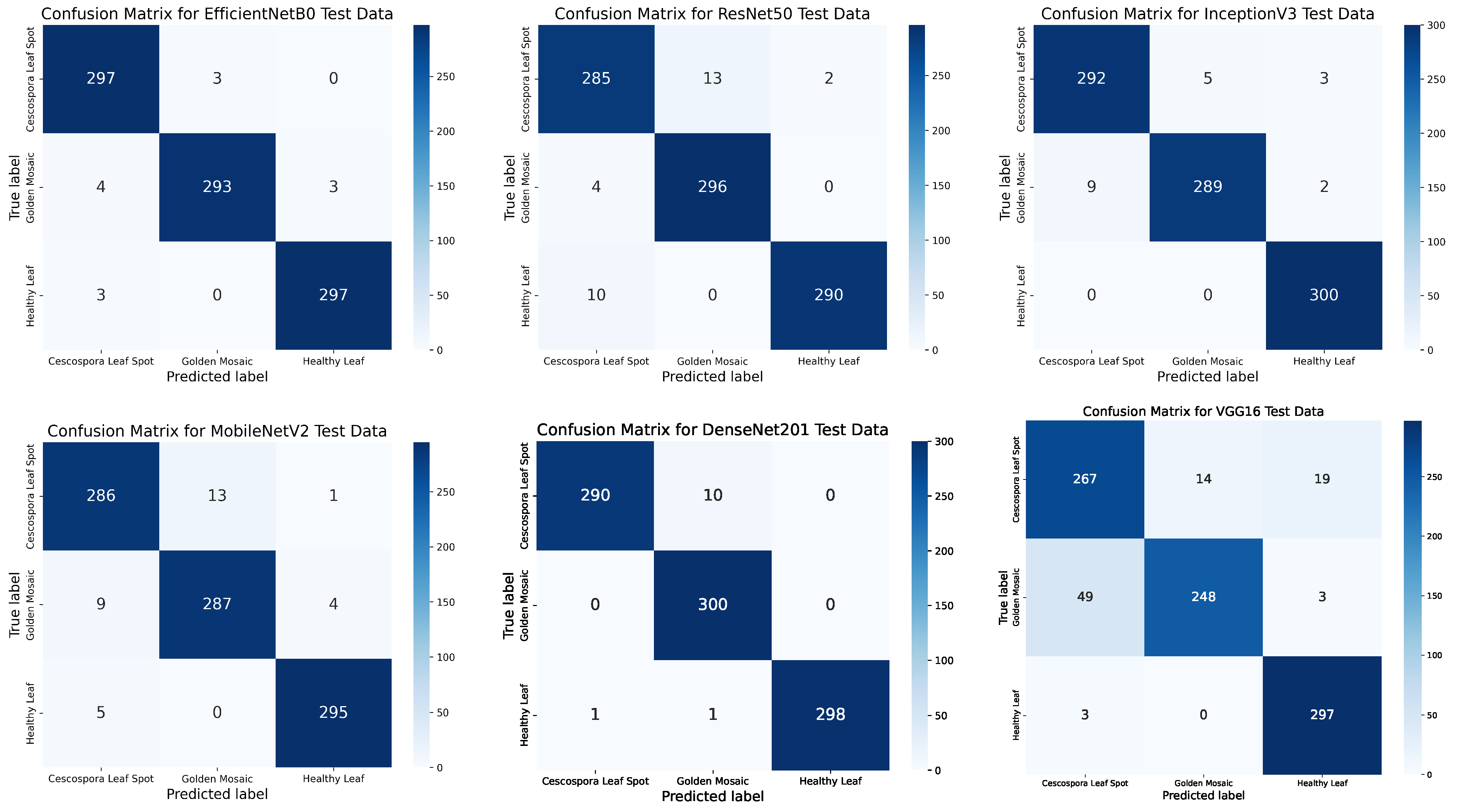
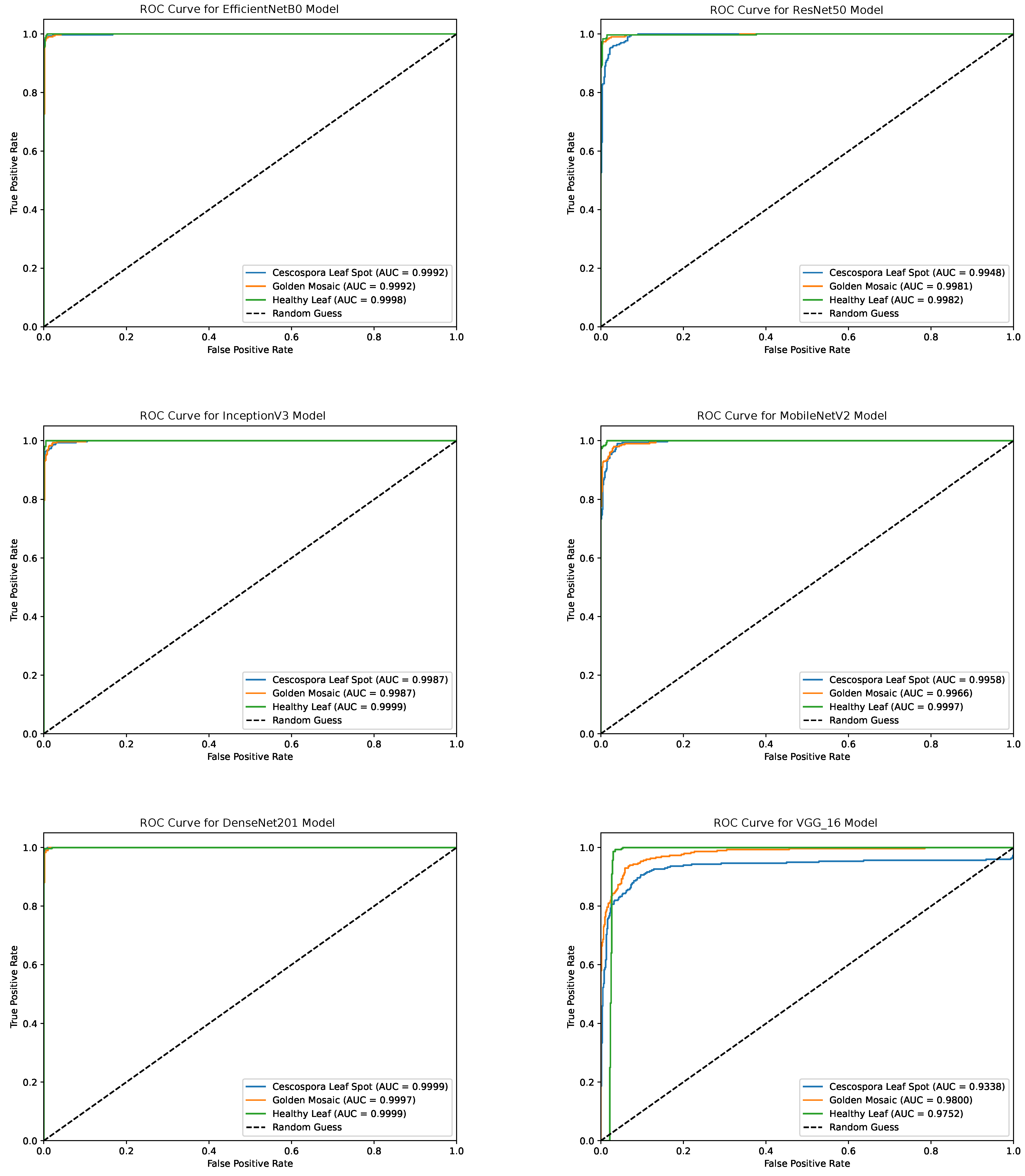
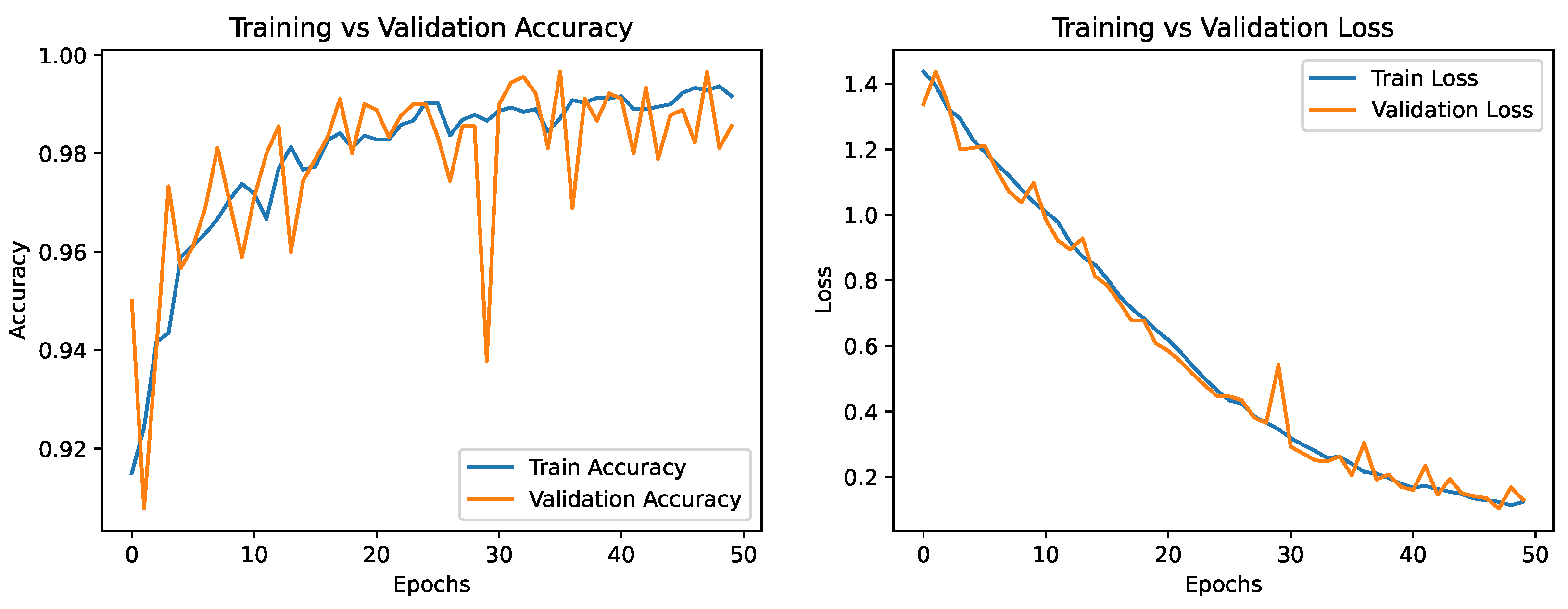
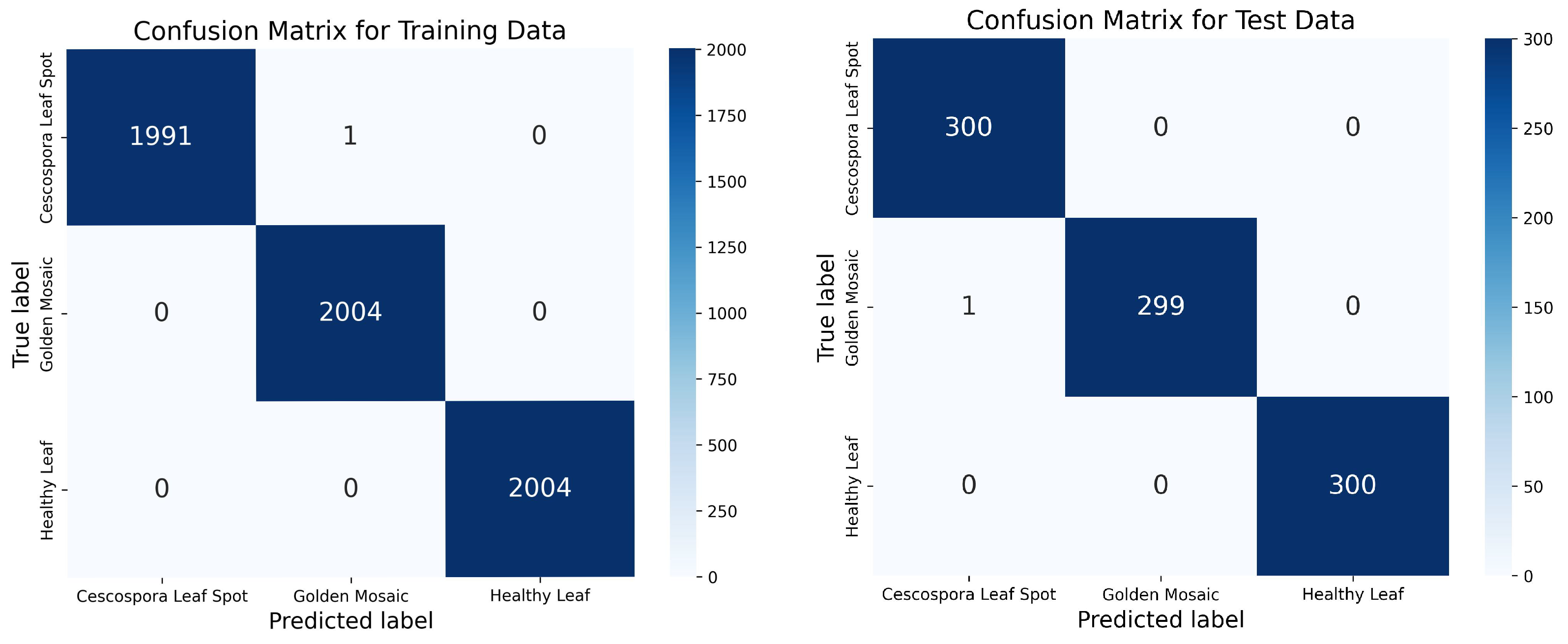
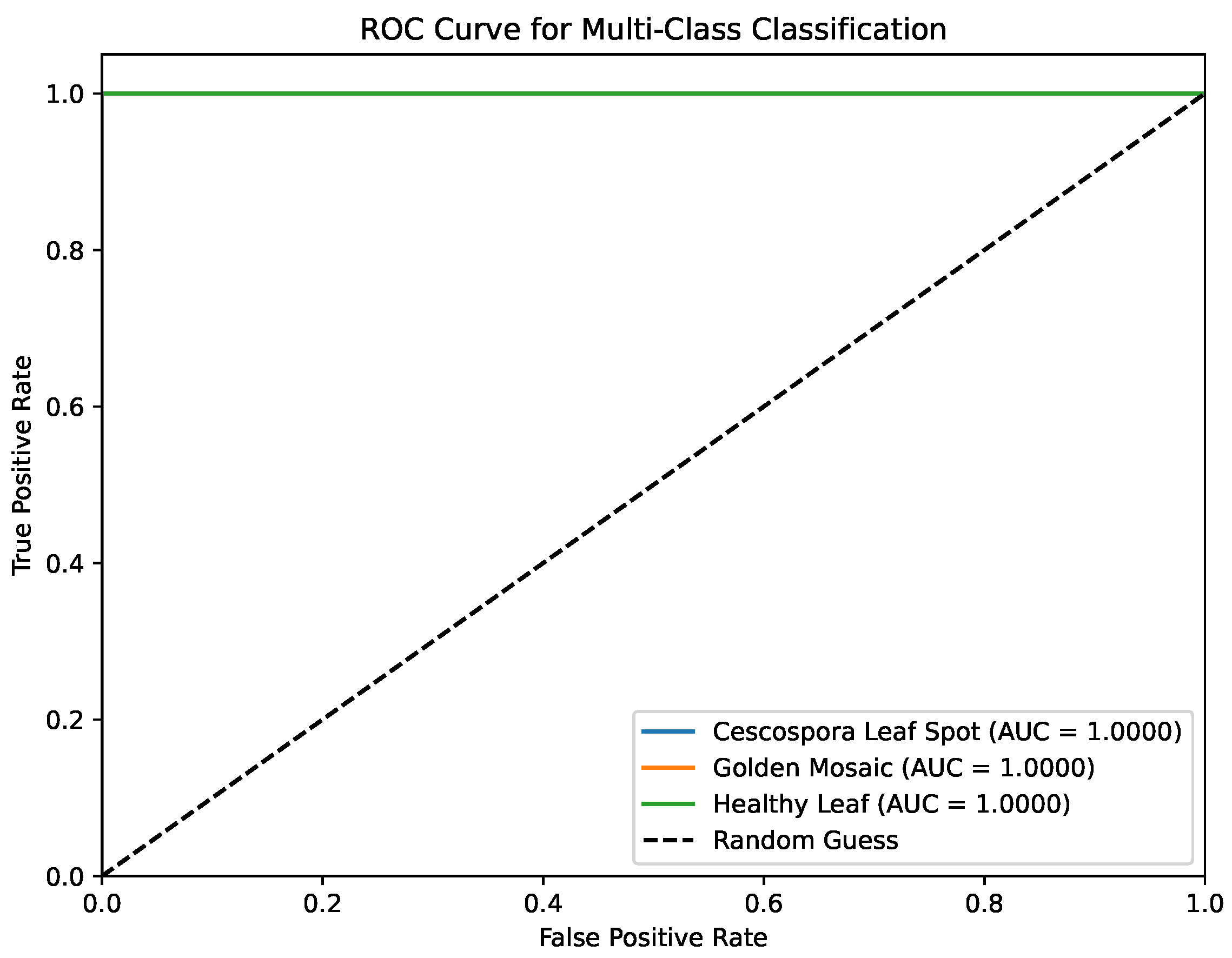
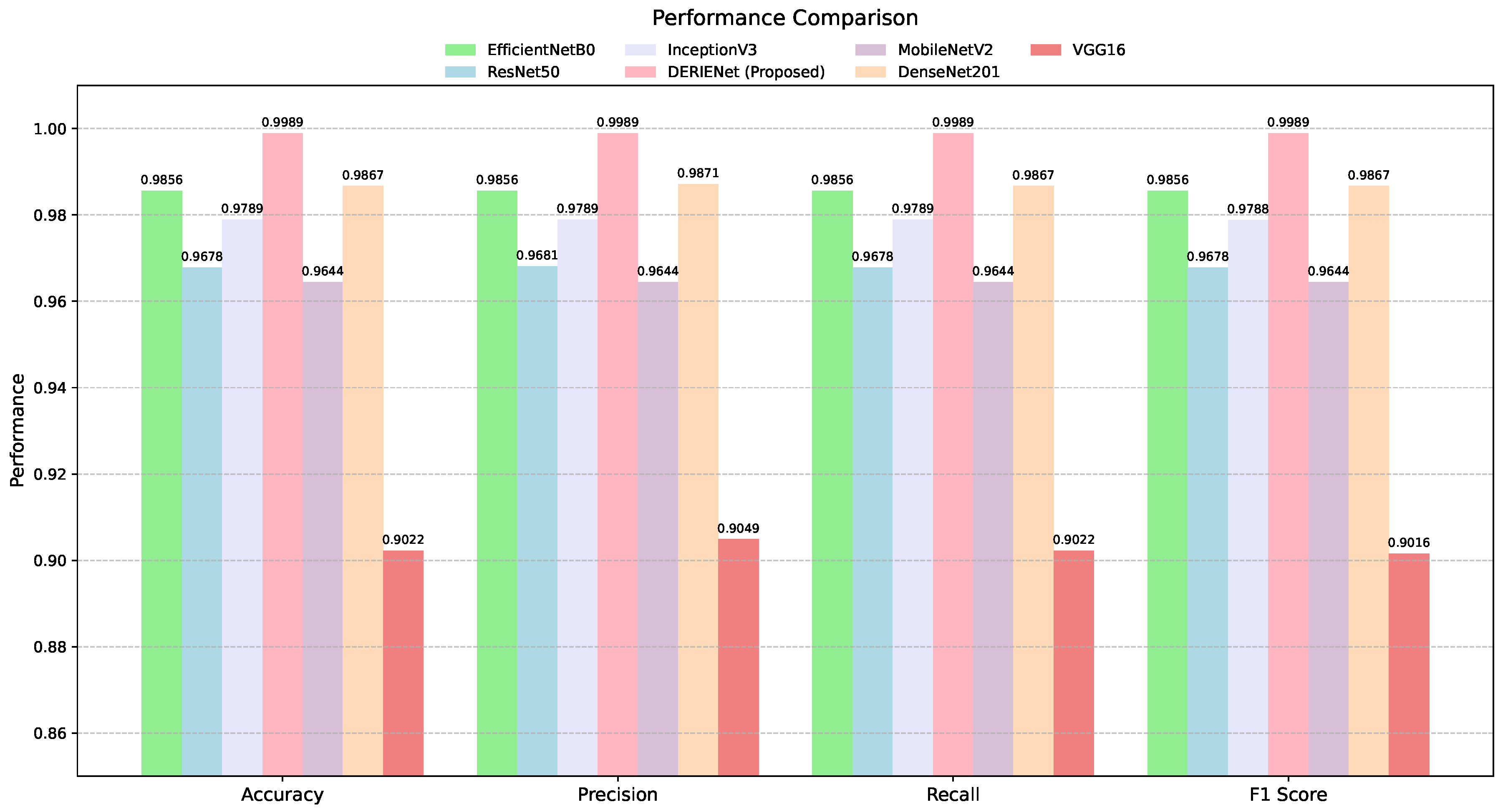
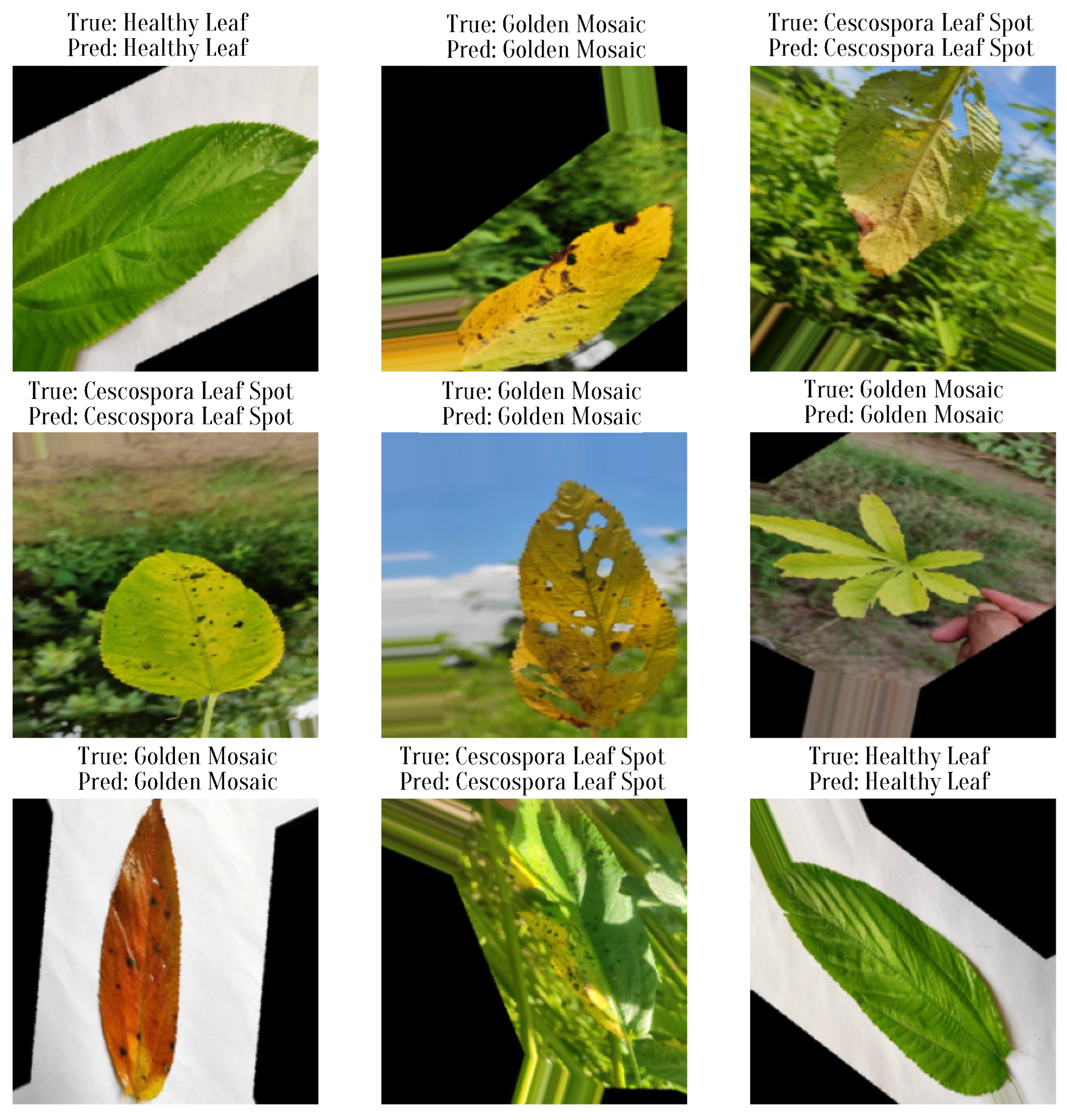
| Ref. | Model(s) Used | Dataset | #Images | #Classes | Transfer Learning | Ensemble Learning | Data Augmentation | Accuracy |
|---|---|---|---|---|---|---|---|---|
| [7] | Four-layer CNN | Jute leaf(own) | 4740 | 3 | No | No | Yes | 96% |
| [28] | CNN, Xception, ResNet50, MobileNetV2, VGG19, and EfficientNetB7 | Sugarcane (own) | 2569 | 5 | Yes | Yes | No | 86.53% |
| [29] | CNN, MLP | Rice(own) | 3200 | 4 | No | Yes | No | 95.31% |
| [30] | SVM | Multi-plant (Folio) | 637 | 32 | No | No | No | 92.91% |
| [31] | CNN | Jute leaf | 600 | 2 | No | No | No | 96% |
| [32] | YOLO-JD | Jute leaf and pest | 4418 | 10 | No | No | No | 96.63% |
| [33] | ResNet152 + Custom CNN | Jute leaf(Kaggle) | 1820 | 3 | Yes | No | No | 98.41% |
| [35] | ResNet50 | Jute leaf(Kaggle) | 1820 | - | Yes | No | Yes | 94% |
| [36] | DCNN | Jute pest | 1535 | 4 | Yes | No | No | 95.86% |
| [38] | DenseNet201 | Jute pest | 380 per class | 17 | Yes | No | Yes | 99% |
| [43] | FL-based CNN | Jute leaf | - | 5 | No | No | No | 98% |
| Class | Precision (%) | Recall (%) | F1-Score (%) | Support |
|---|---|---|---|---|
| Cercospora Leaf Spot | 99.67 | 100 | 99.83 | 300 |
| Golden Mosaic | 100 | 99.67 | 99.83 | 300 |
| Healthy Leaf | 100 | 100 | 100 | 300 |
| Accuracy | 99.89 | 900 | ||
| Macro Average | 99.89 | 99.89 | 99.89 | 900 |
| Weighted Average | 99.89 | 99.89 | 99.89 | 900 |
| Model Name | Train Results | Test Results | Train Accuracy | Test Accuracy | ||||
|---|---|---|---|---|---|---|---|---|
| Precision | Recall | F1-Score | Precision | Recall | F1-Score | |||
| EfficientNetB0 | 99.80% | 99.80% | 99.80% | 98.56% | 98.56% | 98.56% | 99.83% | 98.56% |
| ResNet50 | 96.54% | 96.47% | 96.44% | 96.81% | 96.78% | 96.78% | 97.17% | 96.78% |
| InceptionV3 | 98.91% | 98.90% | 98.90% | 97.89% | 97.89% | 97.88% | 99.02% | 97.89% |
| MobileNetV2 | 98.01% | 97.97% | 97.97% | 96.44% | 96.44% | 96.44% | 98.25% | 96.44% |
| DenseNet201 | 99.07% | 99.05% | 99.05% | 98.71% | 98.67% | 98.67% | 99.27% | 98.67% |
| VGG16 | 92.47% | 92.45% | 92.41% | 90.49% | 90.22% | 90.16% | 92.70% | 90.22% |
| DERIENet (Proposed) | 99.98% | 99.98% | 99.98% | 99.89% | 99.89% | 99.89% | 99.95% | 99.89% |
| Model | Test Classification Accuracy |
|---|---|
| EfficientNetB0 + InceptionV3 | 99.44% |
| EfficientNetB0 + ResNet50 | 99.67% |
| ResNet50 + InceptionV3 | 98.89% |
| EfficientNetB0 + ResNet50 + InceptionV3 | 85.71% |
| (Without GLOAR) | |
| EfficientNetB0 + ResNet50 + InceptionV3 | 99.22% |
| (With L1 Regularization) | |
| DERIENet (Proposed) | 99.89% |
| No. | Model | Ref. | Accuracy |
|---|---|---|---|
| 1 | four-layer CNN | Uddin et al. [7] | 96.21% |
| 2 | CNN | Karim et al. [31] | 95.45% |
| 3 | ResNet152 + Custom CNN | Akand et al. [33] | 98.98% |
| 4 | ResNet50 | Kaushik et al. [35] | 96.50% |
| 5 | DCNN | Sourav et al. [36] | 96.33% |
| 6 | DenseNet201 | Talukder et al. [38] | 98.21% |
| 7 | Lightweight CNN | Rana et al. [39] | 95.43% |
| 8 | FL + CNN | Rajput et al. [42] | 97.67% |
| 9 | DERIENet | Our Proposed Method | 99.89% |
Disclaimer/Publisher’s Note: The statements, opinions and data contained in all publications are solely those of the individual author(s) and contributor(s) and not of MDPI and/or the editor(s). MDPI and/or the editor(s) disclaim responsibility for any injury to people or property resulting from any ideas, methods, instructions or products referred to in the content. |
© 2025 by the authors. Licensee MDPI, Basel, Switzerland. This article is an open access article distributed under the terms and conditions of the Creative Commons Attribution (CC BY) license (https://creativecommons.org/licenses/by/4.0/).
Share and Cite
Tanny, M.T.Y.; Sultana, T.; Biswas, M.E.; Modok, C.K.; Akter, A.; Uddin, M.S.; Hossain, M.D. DERIENet: A Deep Ensemble Learning Approach for High-Performance Detection of Jute Leaf Diseases. Information 2025, 16, 638. https://doi.org/10.3390/info16080638
Tanny MTY, Sultana T, Biswas ME, Modok CK, Akter A, Uddin MS, Hossain MD. DERIENet: A Deep Ensemble Learning Approach for High-Performance Detection of Jute Leaf Diseases. Information. 2025; 16(8):638. https://doi.org/10.3390/info16080638
Chicago/Turabian StyleTanny, Mst. Tanbin Yasmin, Tangina Sultana, Md. Emran Biswas, Chanchol Kumar Modok, Arjina Akter, Mohammad Shorif Uddin, and Md. Delowar Hossain. 2025. "DERIENet: A Deep Ensemble Learning Approach for High-Performance Detection of Jute Leaf Diseases" Information 16, no. 8: 638. https://doi.org/10.3390/info16080638
APA StyleTanny, M. T. Y., Sultana, T., Biswas, M. E., Modok, C. K., Akter, A., Uddin, M. S., & Hossain, M. D. (2025). DERIENet: A Deep Ensemble Learning Approach for High-Performance Detection of Jute Leaf Diseases. Information, 16(8), 638. https://doi.org/10.3390/info16080638









